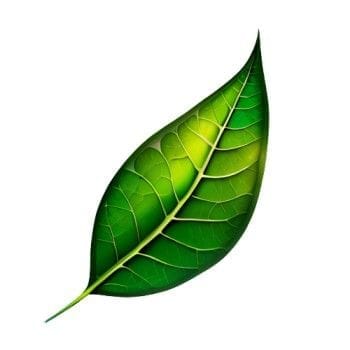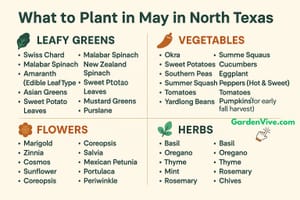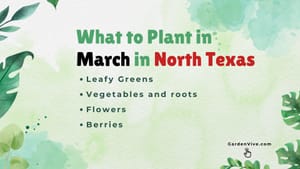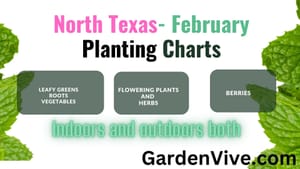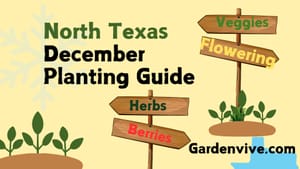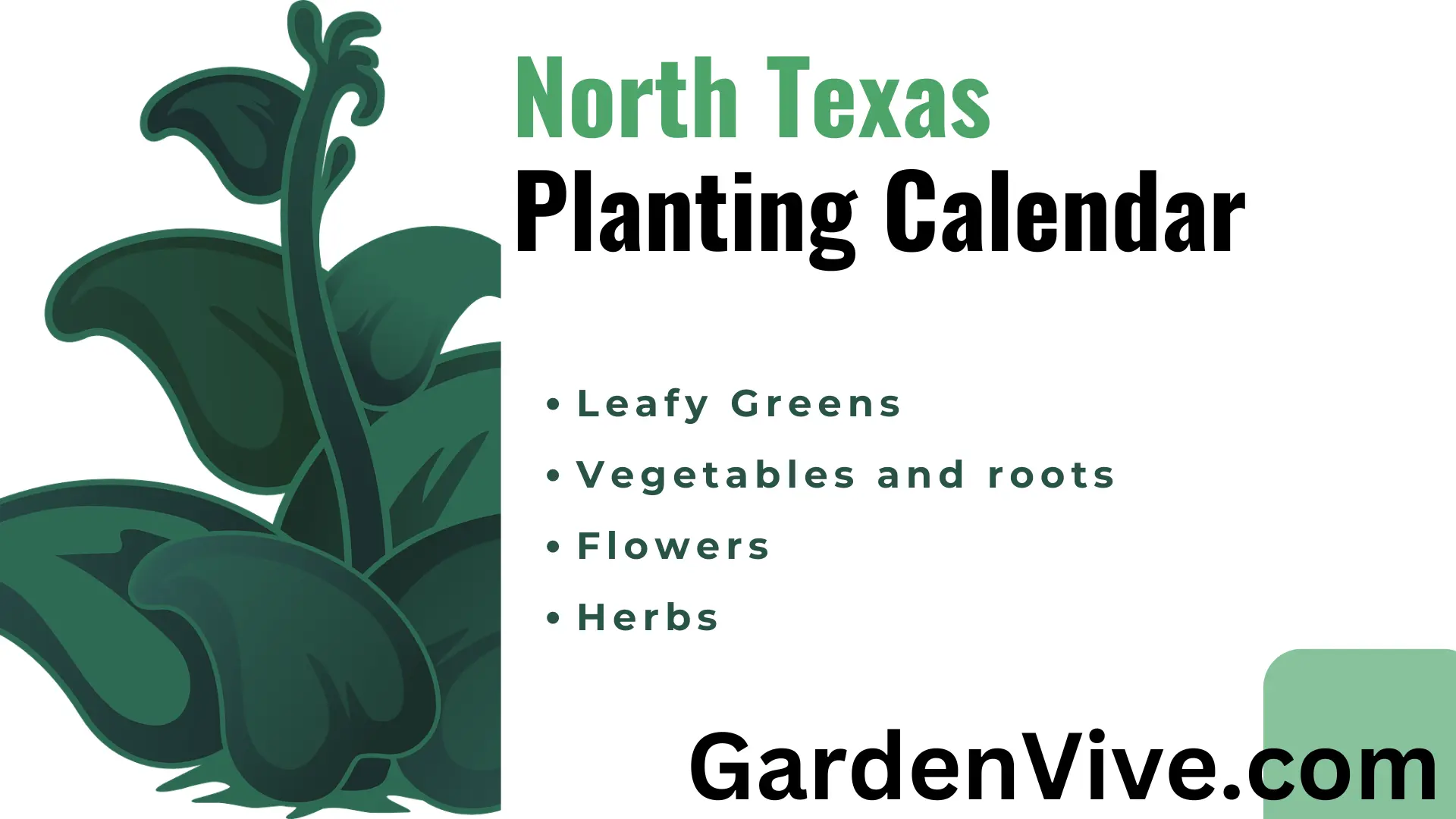
Gardening in North Texas is unique compared to other parts of Texas. My grandpa (Born in 1939) grew up here and spent a lifetime learning the ins and outs of local gardening. Drawing from his wealth of knowledge, I’ve put together a comprehensive Planting Calendar for North Texas. I can confidently say that if you search online, you won’t find a planting calendar that covers such a wide range of plants in such an organized and thorough way. This is a complete year-round planting guide for North Texas.
To make this planting calendar organized, I have separated the plants into 4 categories:
- Leafy Greens
- Vegetables and roots
- Flowers
- Herbs
I could insert more data in the table, but it will be difficult for us to view on a webpage. Thus I have created a full planting guide with planting seasons and date range in a PDF form. As it took me almost 1 month to organize my experiences all together in an eBook, I am selling it online. If you wish you can check it out:
North Texas Planting Guide eBook (Buy Now)( I have set the price to only 5$ so that it is accessible for all. During Purchase, you can simply add any fair price you like to motivate me and my grandpa to create more books on North Texas Gardening! If you do not like the book, I will simply refund the amount you paid. Your feedback is important to me)
Now back to the main article,
Considering the climate of North Texas we have built this planting calendar. My grandpa says, "You have to smell and feel the climate to be an expert gardener".
If you are looking for a summer planting calendar, you can pick the plants that have a growing season between June and mid-September. For spring, you can pick March to May.
If you are an adventurous gardener then you can go check my Early fall Planting calendar for North Texas (What to plant in October).
Let's start with Leafy Greens!
Leafy Greens Planting Calendar for North Texas
| Plant Name | Sowing Method | Growing Season (Direct Sowing) | Growing Season (Transplanting) |
|---|---|---|---|
| Spinach | Direct Sowing | Feb 15 - Mar 15, Sept 1 - Nov 1 | |
| Kale | Both | Feb 15 - Mar 15, Sept 1 - Nov 1 | Jan 15 - Feb 15 |
| Lettuce | Both | Feb 15 - Mar 15, Sept 1 - Nov 1 | Jan 15 - Feb 15 |
| Swiss Chard | Direct Sowing | Feb 15 - Apr 1, Sept 1 - Oct 15 | |
| Arugula | Direct Sowing | Feb 15 - Mar 15, Sept 1 - Nov 1 | |
| Collard Greens | Both | Feb 15 - Mar 15, Sept 1 - Nov 1 | Jan 15 - Feb 15 |
| Mustard Greens | Direct Sowing | Feb 15 - Mar 15, Sept 1 - Nov 1 | |
| Endive | Both | Feb 15 - Mar 15, Sept 1 - Nov 1 | Jan 15 - Feb 15 |
| Romaine Lettuce | Both | Feb 15 - Mar 15, Sept 1 - Nov 1 | Jan 15 - Feb 15 |
| Bok Choy | Both | Feb 15 - Apr 1, Sept 1 - Nov 1 | Jan 15 - Feb 15 |
| Cabbage | Transplanting | Jan 15 - Feb 15 | |
| Radicchio | Direct Sowing | Feb 15 - Mar 15, Sept 1 - Nov 1 | |
| Watercress | Direct Sowing | Feb 15 - Mar 15, Sept 1 - Nov 1 | |
| Escarole | Direct Sowing | Feb 15 - Mar 15, Sept 1 - Nov 1 | |
| Beet Greens | Direct Sowing | Feb 15 - Mar 15, Sept 1 - Nov 1 |
Here is the visual planting calendar for Leafy Greens - North Texas:
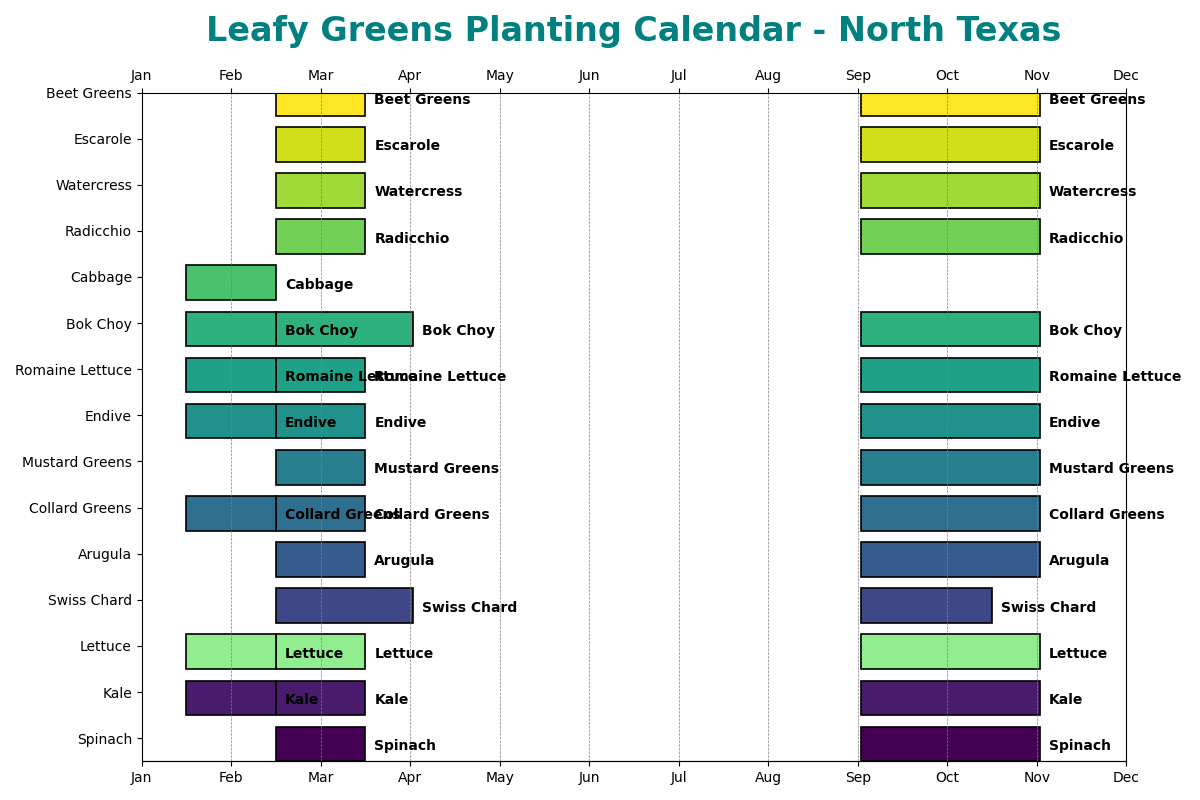
In this list, I have shown the growing season for both direct sowing and transplanting and you might be wondering why transplanting dates are earlier than direct sowing dates:
I am considering that you are growing the saplings from the seeds indoors. In this way, saplings will have time to grow in a controlled environment. If you are not an expert in gardening pick the direct seed-sowing method and follow the dates mentioned in my list.
Bonus tip: For direct sowing, you can see that within a few days, the saplings will be crowded. You need to thin them. Crowded plants compete for nutrients and may not thrive.
Vegetables & Roots Planting Calendar for North Texas
| Plant Name | Planting Method | Planting Time (Date Range) | Best Variety Recommendation | Harvesting Time (Days) |
|---|---|---|---|---|
| Bell Peppers | Transplant | Mar 15 - May 1 | California Wonder, Big Bertha | 60-90 |
| Tomatoes | Transplant | Mar 15 - May 1 | Celebrity, Roma, Cherry | 60-85 |
| Cucumbers | Direct Sowing | Apr 1 - Jun 1 | Marketmore, Straight Eight | 50-60 |
| Asparagus (Crown) | Crowns | Jan 15 - Mar 15 | Jersey Knight, Mary Washington | 2nd year onward |
| Brussels Sprouts | Transplant | Aug 1 - Sept 15 | Jade Cross, Long Island Improved | 90-100 |
| Cantaloupe | Direct Sowing | Apr 1 - May 15 | Hale's Best, Ambrosia | 75-90 |
| Zucchini | Direct Sowing | Apr 1 - Jun 1 | Black Beauty, Cocozelle | 45-60 |
| Carrots | Direct Sowing | Feb 15 - Apr 1, Sept 1 - Oct 15 | Danvers, Nantes | 70-80 |
| Beets | Direct Sowing | Feb 15 - Apr 1, Sept 1 - Oct 15 | Detroit Dark Red, Chioggia | 50-60 |
| Radishes | Direct Sowing | Feb 15 - Apr 1, Sept 1 - Oct 15 | Cherry Belle, French Breakfast | 25-35 |
| Onions | Both | Transplant: Jan 15 - Feb 15 | Direct: Feb 15 - Mar 1 | Texas Super Sweet, Yellow Granex | 100-120 |
| Garlic | Direct Sowing | Oct 1 - Nov 1 | Softneck, Hardneck | 180-210 |
| Potatoes | Both | Transplant: Jan 15 - Feb 15 | Direct: Feb 15 - Mar 1 | Yukon Gold, Red Pontiac | 90-110 |
| Turnips | Direct Sowing | Feb 15 - Apr 1, Sept 1 - Oct 15 | Purple Top, Seven Top | 50-60 |
| Parsnips | Direct Sowing | Feb 15 - Apr 1 | Hollow Crown, Harris Model | 110-120 |
| Sweet Potatoes | Transplanting | Apr 1 - May 1 | Beauregard, Covington | 100-120 |
| Cabbage | Transplanting | Jan 15 - Feb 15 | Green Acre, Golden Acre | 90-100 |
| Cauliflower | Transplanting | Jan 15 - Feb 15 | Snowball, Amazing | 80-100 |
| Broccoli | Transplanting | Jan 15 - Feb 15 | Calabrese, Waltham 29 | 80-100 |
| Peas | Direct Sowing | Feb 1 - Mar 15 | Little Marvel, Sugar Snap | 60-70 |
| Kohlrabi | Both | Transplant: Jan 15 - Feb 15 | Direct: Feb 15 - Mar 15 | Early White Vienna, Purple Vienna | 55-65 |
| Okra | Direct Sowing | Apr 15 - Jun 15 | Clemson Spineless, Red Burgundy | 50-60 |
| Eggplant | Transplant | Mar 15 - May 1 | Black Beauty, Ichiban | 70-85 |
| Green Beans | Direct Sowing | Apr 1 - Jun 15 | Blue Lake, Kentucky Wonder | 50-60 |
| Squash | Direct Sowing | Apr 1 - Jun 15 | Yellow Crookneck, Spaghetti | 40-50 |
| Pumpkins | Direct Sowing | Apr 15 - Jul 1 | Jack O’ Lantern, Sugar Pie | 90-120 |
| Watermelon | Direct Sowing | Apr 15 - Jun 15 | Crimson Sweet, Sugar Baby | 75-95 |
| Hot Peppers | Transplant | Mar 15 - May 1 | Jalapeno, Habanero | 60-90 |
| Melons | Direct Sowing | Apr 1 - May 15 | Musk Melon, Honeydew | 75-90 |
| Gourds | Direct Sowing | Apr 15 - May 15 | Calabash, Birdhouse | 90-120 |
| Chili Peppers | Transplant | Mar 15 - May 1 | Cayenne, Serrano | 70-85 |
If you want to enhance the health and productivity of your garden, you should consider companion planting. It will help to repel pests, improve soil nutrients, and even boost plant growth. For example: Carrots grow well with onions and garlic, Peas add nitrogen to the soil.
In this list, I did not remove a few leafy greens as you can consider them as veggies as well.
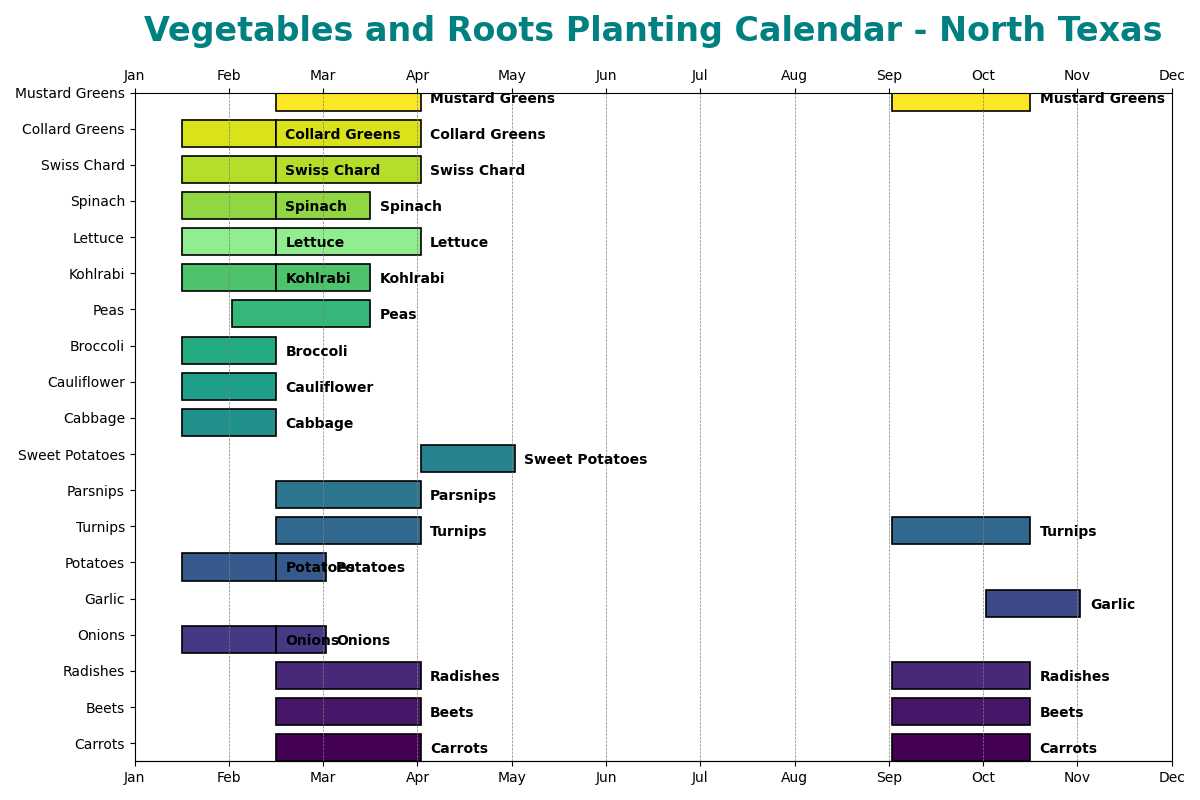
You can see in my list, for a few specific veggies I have added two date ranges as you can grow them twice in a year.
Flower Planting Calendar for North Texas
| Flower Name | Planting Time | Flowering Season | Difficulty Level | Type | Variety Recommendation |
|---|---|---|---|---|---|
| Sunflowers | Mar 15 - May 15 | Jun 1 - Aug 31 | Easy | Annual | Mammoth, Autumn Beauty |
| Pansy | Late September to Early November | Late Fall to Early Spring | Easy | Cool-season annual | Matrix Series, Delta Series, Cool Wave |
| Milkweed | Mar 15 – May 31 | May – Sep | Easy | Perennial | Butterfly Weed, Swamp Milkweed |
| Zinnias | Mar 15 - May 15 | Jun 1 - Frost | Easy | Annual | Benary’s Giant, Cut and Come Again |
| Marigolds | Feb 15 - Apr 15 | May 1 - Frost | Easy | Annual | French Marigold, African Marigold |
| Roses | Feb 15 - Apr 15 | Spring to Frost | Moderate | Perennial | Knock Out, Hybrid Tea, Drift, Floribunda |
| Cosmos | Mar 15 - May 15 | Jun 1 - Frost | Easy | Annual | Sensation Mix, Seashells |
| Petunias | Feb 15 - Apr 15 | Apr 1 - Frost | Moderate | Annual | Wave Petunia, Supertunia |
| Snapdragons | Jan 15 - Feb 15 | Mar 1 - May 15 | Moderate | Perennial (often treated as annual) | Rocket Mix, Madame Butterfly |
| Lavender | Feb 15 - Apr 15 | May 1 - Jul 31 | Moderate | Perennial | Munstead, Phenomenal |
| Black-eyed Susans | Mar 15 - May 15 | Jun 1 - Aug 31 | Easy | Perennial | Goldsturm, Indian Summer |
| Coreopsis | Mar 15 - May 15 | Jun 1 - Aug 31 | Easy | Perennial | Early Sunrise, Moonbeam |
| Geraniums | Feb 15 - Apr 15 | May 1 - Frost | Moderate | Perennial (often treated as annual) | Maverick, Calliope |
| Daylilies | Feb 15 - Mar 15 | Jun 1 - Aug 31 | Easy | Perennial | Stella de Oro, Happy Returns |
| Peonies | Fall (Oct 1 - Nov 30) | May 1 - Jun 30 | Moderate | Perennial | Sarah Bernhardt, Festiva Maxima |
| Bluebonnet | Fall (Mid Oct - Mid Nov) | March 15 - May 10 | Moderate | Annual | Texas Bluebonnet |
| Rudbeckia | Mar 15 - May 15 | Jun 1 - Aug 31 | Moderate | Perennial | Cherry Brandy, Goldsturm |
| Asters | Feb 15 - Apr 15 | Sep 1 - Oct 31 | Moderate | Perennial | New England Aster, Purple Dome |
| Hollyhocks | Mar 15 - May 15 | Jun 1 - Aug 31 | Moderate | Biennial | Chater’s Double, Indian Spring |
| Tulips | Nov 1 - Dec 15 | Mar 1 - Apr 15 | Moderate | Perennial (often treated as annual) | Darwin Hybrid, Triumph |
| Daffodils | Nov 1 - Dec 15 | Feb 1 - Mar 15 | Easy | Perennial | King Alfred, Ice Follies |
For flowering plants, I have added the flowering season and type of the plant (annual or perennial).
In North Texas, people start to sow the flowering seeds in early February. If you're itching to get those garden gloves on, you're in luck! February and March are the prime months to plant early-blooming beauties like Snapdragons and Petunias.
If you wish you can check my article: Flowering plants that you can grow indoors in North Texas.
My personal favorites on the list are zinnias, lavender, sunflowers, and peonies.
I love the sunflower when I visit my grandpa's place. But in South Florida due to humidity, I face Powdery mildew on Sunflower Leaves.
Herb Planting Calendar for North Texas
| Herb Name | Planting Time | Harvesting Time | Difficulty Level | Type |
|---|---|---|---|---|
| Basil | Apr 1 - Jun 1 | Jun 15 - Frost | Easy | Annual |
| Thyme | Mar 15 - Apr 15 | May 1 - Frost | Easy | Perennial |
| Rosemary | Mar 15 - May 15 | May 15 - Frost | Moderate | Perennial |
| Cilantro | Mar 1 - May 15 | May 1 - Jun 15 | Easy | Annual |
| Parsley | Feb 15 - Apr 15 | May 1 - Frost | Moderate | Biennial |
| Sage | Mar 15 - May 15 | May 15 - Frost | Moderate | Perennial |
| Dill | Mar 1 - May 15 | May 1 - Jul 15 | Easy | Annual |
| Mint | Mar 15 - Apr 15 | May 1 - Frost | Easy | Perennial |
| Oregano | Mar 15 - Apr 15 | May 1 - Frost | Easy | Perennial |
| Chives | Mar 15 - Apr 15 | May 1 - Frost | Easy | Perennial |
| Fennel | Mar 1 - May 15 | May 1 - Jul 15 | Moderate | Perennial |
| Tarragon | Mar 15 - Apr 15 | May 15 - Frost | Moderate | Perennial |
| Lavender | Feb 15 - Apr 15 | May 1 - Jul 31 | Moderate | Perennial |
| Sweet Bay | Mar 15 - May 15 | Jun 1 - Frost | Moderate | Perennial |
If you do not like herbs that much then you might not be interested in this list. But give it a try. Their maintenance is easiest and most of those are perennial (that's a plus point).
Yes, Lavender is a flowering plant and herb at the same time. If you wish you can plant the herbs in a pot as well.
Shrubs
I have added a few new columns for the shrubs like if they are evergreen or not, flowering or not etc.
| Plant Name | Best Planting Time | Height (Max) | Flowering | Evergreen |
|---|---|---|---|---|
| Texas Sage | March 15 - May 15 | 4-6 feet | Yes | Yes |
| Turk's Cap | April 1 - June 30 | 2-4 feet | Yes | No |
| Indian Hawthorn | October 15 - November 30 | 3-6 feet | Yes | Yes |
| Yaupon Holly | September 1 - October 31 | 10-20 feet | No | Yes |
| Esperanza | April 15 - June 15 | 4-6 feet | Yes | No |
| American Beautyberry | February 15 - April 15 | 3-6 feet | Yes | No |
| Abelia | March 1 - May 1 | 3-6 feet | Yes | Yes |
| Winter Jasmine | November 15 - January 15 | 3-4 feet | Yes | No |
| Southern Wax Myrtle | February 1 - March 30 | 10-20 feet | No | Yes |
| Coralberry | March 1 - April 30 | 2-4 feet | No | No |
Berries to plant in North Texas
| Berry Name | Best Planting Time | Sunlight Requirements | Soil Type | Variety Recommendation (North Texas) |
|---|---|---|---|---|
| Strawberry | Early Spring or Fall | Full Sun | Slightly Acidic, Well-drained | Chandler, Sequoia, Quinault |
| Blackberry | Early Spring | Full Sun to Partial Shade | Loamy, Well-drained | Natchez, Kiowa, Arapaho |
| Raspberry | Early Spring | Full Sun | Slightly Acidic, Well-drained | Dorman Red, Heritage |
| Blueberry | Late Winter to Early Spring | Full Sun | Acidic, Sandy | Brightwell, Tifblue, Climax (Rabbiteye) |
| Goji Berry | Spring | Full Sun | Well-drained, Tolerates Poor Soil | Crimson Star, Phoenix Tears |
Yes, you can grow the above-mentioned berries easily in North Texas.
It takes a lot of effort and time to generate these lists and visual data. If possible subscribe to this site. It's Free! But it will motivate me to bring more content like this.
